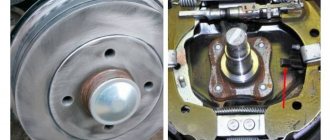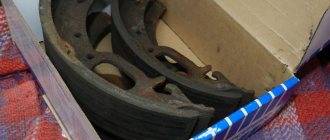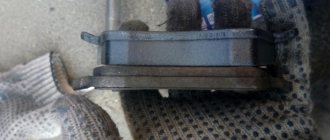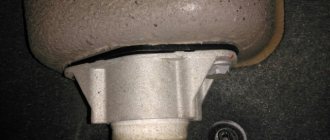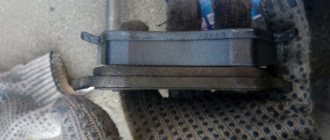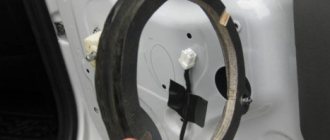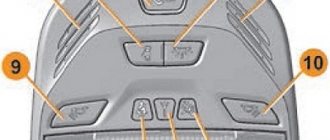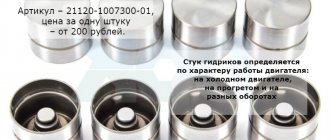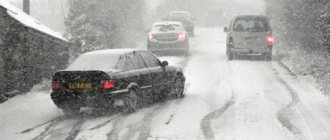Troubleshooting the drum
Diagnosis of the brake system is usually carried out during a vehicle technical inspection. Another reason is the appearance of signs of malfunctions.
It is best to check the effectiveness of braking and identify a failed wheel on a special stand. On it, the wheels are spun to a speed of 15-20 km/h, and then braking is applied. The force created by the system is reflected in the instrument readings. Based on these data, as well as the results of the technical inspection, the specialist issues his recommendations.
The decision on the method of repair or replacement of any part is usually made at the defect detection stage, which should not be confused with diagnostics.
The presence of ABS, unfortunately, worsens the initial diagnosis, since the system prevents skidding.
The reduction in braking force on the rear axle is more pronounced in reverse mode. Cyclic jerks during braking most likely indicate the ovality of the inner surface of the drum. These jerks create response pulsations in the pedal.
The handbrake helps confirm this assumption - it only acts on the rear wheels. For example, when you press the pedal, you hear a strange creak, but it is unclear where it is coming from. Then, pressing the handbrake lever button, carefully tighten the latter. If the sound appears again, it means it comes from the rear wheels, if not, it comes from the front wheels.
The most characteristic of the extraneous sounds caused by faulty brakes is the grinding sound of metal. It occurs when the brake pad lining wears out or breaks. In this case, the brake drum wears out intensively. In this case, it is also good to use the handbrake.
Manipulations related to road testing and brake diagnostics should be performed in safe places. If brake fluid leaks and gets on the drum, the latter will become oily and the wheel will hardly brake.
A faulty wheel is also determined by the temperature of the drum. The part heats up due to friction. The wheel bolts become hot. The increased travel of the parking brake lever is due, among other things, to abrasion of the drum, but this is the total result of wear of all components.
Other analogues for rear suspension
| Name | Price | Buyer Experience |
| TRW GDB1384 | RUB 1,734 | Excellent braking, silent operation, no dust |
| UBS B1105007 | RUB 2,335 | Excellent braking, heavy wear at high speeds |
| Sangsin Brake SP1709 | RUB 1,690 | Soft braking, does not wear out the disc |
| Brembo P23064 (England) | RUB 1,615 | Moderately dusty, do not creak down to a temperature of -32 degrees |
| Intelli D204E | 592 rub. | Good braking, no dust, a lot of creaking |
| NISSHINBO NP2010 | RUB 1,894 | Excellent braking without squeaks |
| UBS Performance B11-05-007 | 840 rub. | No dust, squeaks with medium pedal presses, braking efficiency decreases with increasing speed |
| АDR 01131 | 350 rub. | Price/quality ratio, no squeaks, decent braking, problems with installation in a regular place, wears out the disc |
| Finwale | 925 rub. | Medium quality |
| Hankook Frixa FPE127 | RUB 1,521 | They squeak terribly (there are no anti-squeak plates), braking is good, easy installation in the original place, minimal disc wear |
| TRW GDB3332 | 1,700 rub. | Quality close to original |
| Kortech KRT1805 | 500 rub. | There is no anti-creak plate, dusty, slight creaking, excellent braking |
| Remsa 727 00 | 1,650 rub. | Good braking, no squeaking |
| Transmaster Universal TR204C | 427 rub. | Unknown manufacturer, Transmaster is only a packer, poor braking at low speeds, severe wear, cracks, deformations at high speeds |
| Ashika 5000013 | 794 rub. | Creaking after long periods of inactivity, good braking |
How to replace the pads on a Lada Vesta with your own hands, see here:
Possible causes of increased wear
Drum wear is inextricably linked with pad wear. Moreover, the dependence can be both direct and inverse.
Reducing the life of drums is facilitated by:
- The quality of the pads and the brake disc itself.
- Technical characteristics of the pads. The lining can be of high quality, but at the same time “soft”. It brakes smoothly, but wears out faster than the “hard” one. But it protects the surface of the drum. A “hard” pad is more aggressive towards the brake drum, so the mileage of the latter is shorter.
- Frequent use of brakes is driving in city conditions, with many traffic lights and crossings.
- Aggressive driving. Constant sharp braking, overheating of mechanisms.
- Off-road driving. The terrain is constantly changing, and every now and then you have to slow down. At the same time, dust and sand do not spare the working surfaces of mating pairs (pads, drums).
- Untimely maintenance, delayed repairs. If you can hear the sound of the steel base of the pad touching the disc, it means the wear has long been beyond the limit. You shouldn’t convince yourself that it’s not scratching too much yet. We urgently need to repair the system while there is a chance to get away with replacing the pads. In winter, when approaching your house, you can drive through a puddle and leave the car overnight. The block will freeze to the drum. When starting, the lining slightly detaches from the block, and after a while it completely falls off. For the reasons described above, the drum wears out intensively.
- A handbrake that gets stuck when tightened can cause increased friction, resulting in wear, overheating, and warping of parts.
Popular products of the spare parts group - Brake pads for LADA VESTA SW station wagon (GFK_)
Brake system LADA VESTA SW station wagon (GFK_) Front brake pads Renault Clio III/Logan I/Modus/Grand Modus 04>15 Nissan Micra C+C III/Micra III/Note 03>12 GIRLING 6120171
manufacturer: GIRLING (Germany) article number: 6120171
1 920 a
Brake system LADA VESTA SW station wagon (GFK_) Front disc brake pads Renault Clio III/Clio III Grandtour/Modus/Grand Modus 04>15 Nissan Micra C+C III/Micra III/Note 03>12 HELLA PAGID 8DB355010851
manufacturer: HELLA PAGID (Germany) article number: 8DB355010851
2,010 a
Brake system LADA VESTA SW station wagon (GFK_) Front disc brake pads Renault Clio III/Logan I/Modus/Grand Modus 04>15 Nissan Micra C+C III/Micra III/Note 03>12 Suzuki Swift III 05> Lada Largus 12> Mercedes Citan/Citan Combi 12>21 NIBK PN9805
manufacturer: NIBK (Japan) article number: PN9805
2 410 a
Brake system LADA VESTA SW station wagon (GFK_) Disc brake pads Renault Clio III/Logan I/Modus/Grand Modus 04>15 Nissan Micra C+C III/Micra III/Note 03>12 PILENGA FD-P8010
manufacturer: PILENGA (Italy) article number: FD-P8010
960a
Brake system LADA VESTA SW station wagon (GFK_) Front brake pads Renault Clio III/Logan I/Modus/Grand Modus 04>15 Nissan Micra C+C III/Micra III/Note 03>12 TADASHISA TBP049
manufacturer: TADASHISA article: TBP049
980a
Brake system LADA VESTA SW station wagon (GFK_) Front brake pads Renault Clio III/Logan I/Modus/Grand Modus 04>15 Nissan Micra III/Note/Tiida 03>12 KOTL 22KT
manufacturer: KOTL (Russia) article number: 22KT
1 130 a
Brake system LADA VESTA SW station wagon (GFK_) Front pads set Renault Clio III/Clio III Grandtour/Modus/Grand Modus 04>15 Nissan Note 06>12 Mercedes Citan 12>21 MAPCO 6758
manufacturer: MAPCO (Germany) article number: 6758
1 560 a
Brake system LADA VESTA SW station wagon (GFK_) Front brake pads Renault Clio III/Logan I/Modus/Grand Modus 04>15 Nissan Micra C+C III/Micra III/Note 03>12 GIRLING 6133321
manufacturer: GIRLING (Germany) article number: 6133321
2,010 a
Brake system LADA VESTA SW station wagon (GFK_) Front brake pads Renault Clio III/Logan I/Modus/Grand Modus 04>15 Nissan Micra C+C III/Micra III/Note 03>12 DAFMI D204SM
manufacturer: DAFMI article: D204SM
530a
Brake system LADA VESTA SW station wagon (GFK_) Front brake pads Renault Clio III/Logan I/Modus/Grand Modus 04>15 Nissan Micra III/Note/Tiida 03>12 MENSAN K270201
manufacturer: MENSAN (Türkiye) article number: K270201
820a
Brake system LADA VESTA SW station wagon (GFK_) Front disc brake pads Renault Clio III/Logan I/Modus/Grand Modus 04>15 Nissan Micra C+C III/Micra III/Note 03>12 FINWHALE V1067
manufacturer: FINWHALE (Germany) article: V1067
1 320 a
Brake system LADA VESTA SW station wagon (GFK_) Front disc brake pads Renault Clio III/Logan I/Modus/Grand Modus 04>15 Nissan Micra C+C III/Micra III/Note 03>12 ALLIED NIPPON ADB0984
manufacturer: ALLIED NIPPON (Japan) article number: ADB0984
1 390 a
Brake system LADA VESTA SW station wagon (GFK_) Front disc brake pads Renault Clio III/Logan I/Modus/Grand Modus 04>15 Nissan Micra C+C III/Micra III/Note 03>12 TRIALLI PF1416
manufacturer: TRIALLI (Italy) article number: PF1416
1 560 a
Brake system LADA VESTA SW station wagon (GFK_) Front disc brake pads Renault Clio III/Logan I/Modus/Grand Modus 04>15 Nissan Micra C+C III/Micra III/Note 03>12 WEEN 1511333
manufacturer: WEEN (Netherlands) article number: 1511333
1 660 a
Brake system LADA VESTA SW station wagon (GFK_) Rear brake pads Fiat Panda/Punto/500 99>13 Lada Vesta/Vesta SW/Xray 13>19 FERODO FDB1324
manufacturer: FERODO (Great Britain) article: FDB1324
1,760 a
Brake system LADA VESTA SW station wagon (GFK_) Disc brake pads set Renault Clio III/Logan I/Modus/Grand Modus 04>15 Nissan Micra C+C III/Micra III/Note 03>12 NISSAN 41083AX625
manufacturer: NISSAN (ORIGINAL) article number: 41083AX625
1 890 a
Brake system LADA VESTA SW station wagon (GFK_) Rear brake pads Fiat Panda/Punto/500 99>13 Lada Vesta/Vesta SW/Xray 15> Citroen E-Mehari 16> TEXTAR 2360102
manufacturer: TEXTAR (Germany) article number: 2360102
2 000 a
Brake system LADA VESTA SW station wagon (GFK_) Front disc brake pads Renault Clio II/Clio III/Logan I 01>15 Nissan Micra C+C III/Micra III/Note 03>12 BOSCH 0 986 424 795
manufacturer: BOSCH (Germany) article number: 0 986 424 795
2,030 a
Brake system LADA VESTA SW station wagon (GFK_) Front disc brake pads Renault Clio III/Clio III Grandtour/Modus/Grand Modus 04>15 Nissan Micra C+C III/Micra III/Note 03>12 BREMBO P68033
manufacturer: BREMBO (Italy) article number: P68033
2 210 a
Brake system LADA VESTA SW station wagon (GFK_) Front disc brake pads Renault Clio III/Logan I/Modus/Grand Modus 04>15 Nissan Micra III/Note/Tiida 03>12 RENAULT 4106 084 81R
manufacturer: RENAULT (ORIGINAL) article number: 4106 084 81R
2 380 a
You can also view all spare parts for LADA VESTA SW station wagon (GFK_)
Selecting a drum for Vesta
Drum brakes are installed on Lada Vesta with an engine capacity of 1.6. But these cars are also equipped with disc brakes. The manufacturer equips Vesta with a 1.8 engine only with disks.
In order not to rack your brains over various modifications of spare parts, it is better to select them by the VIN number of the car. This will eliminate the error. There are different options for rear drum repair kits. Namely:
- With ABS ring, without ring.
- With or without bearing.
At the defect detection stage, you need to make a choice so as not to buy too much and not do double work. The stumbling block is the ABS ring. The system only works with the original. It will not function with analogues that have a different number of teeth. Therefore, if a substitute is used, the ring must be rearranged.
In addition to domestic spare parts, there are also Italian ones. In addition, there is repeatedly information on the Internet that this part is identical to the one of the same name for the Ford Fusion. But there are already a lot of analogues to the Ford version, for every taste and budget.
Pads and their articles for the drum mechanism of the rear brake system of Lada Vesta
Original rear drum pads for the Lada Vesta are outrageously expensive, and besides, finding them in retail sales is not so easy:
- 8450076668 — set of Lada brake pads, price ~ 5800 rubles
Agree, the price does not correspond to the status of a budget car. Most often, when replacing the rear brake assembly, analogues are used:
- BP53168 – Fenox, suitable for Lada Vesta
- BS-5717 - Japanese manufacturer Lynx, installed instead of standard ones without modifications
The similarity of spare parts from Ford Fusion is also mentioned, but in this case you may have to resort to minor modifications to the mechanism.
Instructions for replacing the brake drum
You can entrust the replacement of the brake drum to a car service center, but you can also do it yourself if you have the necessary skills. In addition to reliable hands, we will need some more tools and devices.
Required tools and supplies
Before starting repair work, you should stock up on:
- Knife, screwdriver, thick screwdriver, chisel, hammer. That's all for removing the hub plug.
- Hex head 30.
- Collar.
- Extension.
- Torque wrench.
- Balloon wrench.
- Jack.
- Three-legged puller 67.7823-9519.
- Cord brush.
- Rags.
- Solvent, rust converter.
- Wheel chocks.
- Retaining ring remover.
Removing the drum from the hub
In order to remove the brake drum, you must perform the following steps:
- Place the vehicle on a smooth, horizontal surface.
- Secure the machine using stops. It is most effective to install stops under the wheel located diagonally to the raised one (for example, for the raised rear right one, this is the front left one).
- Install the jack.
- Strip the bolts, but do not unscrew them. For now they should press the wheel tightly.
- Hang up the wheel. It is safer to repair the car by placing it on a special rack. Don't settle for a wobbly jack.
- Check the condition of the bearing by spinning the wheel. A faulty bearing may hum. Check wheel play. If a hum is heard or the bearing is loose, it must be replaced.
- Remove the hub nut cap. To do this, you may first need to use a thin screwdriver, or even a knife. Then you should move on to a thicker tool. A chisel sharpened at the optimal angle allows you to quickly knock off a tightly seated cap.
- Unscrew the hub nut after cleaning the axle threads.
- Remove the drum assembly with bearing. If its inner ring is “soured” on the axle, then a puller will be needed.
It is also recommended to flatten the pads. This is done by turning the adjusting toothed nut located on the pad spacer bar. A screwdriver is inserted through the hole in the wheel bolt and the nut is rotated upward. This increases the clearance between the drum and the lining and makes removal easier. If this is not done, then if there is a large wear-out, the pads will cling to the formed shoulder, preventing dismantling.
Brake drum installation
If bearing replacement is required, it is done on a press by installing a mandrel on the outer race. Otherwise the spare part will be damaged. The bearing is secured with a retaining ring using a puller.
Further assembly occurs in the reverse order of removal. Before installation, all mounting surfaces must be cleaned of dirt. It is important not to snag the ABS ring.
The hub bearing nut is tightened using a torque wrench. The tightening torque of the hub nut is 15.8 - 19.2 kg cm (158 - 192 nm).
Wheel nuts are disposable. Their reuse is not permitted.
Even if the rear brake pads have not been changed, the gap still needs to be adjusted after replacing the drum. This vehicle has automatic brake pad adjustment. To configure the mechanism, you need to do the following:
- Depress the brake pedal several times.
- Keeping the pedal depressed, tighten and release the parking brake lever with the button pressed. The auto-tune ratchet inside the wheel will click.
- When the clicking stops, the gaps between the linings and the drum are considered adjusted.
How to carry out defect detection
Professionals consider it necessary to replace or bore the second drum if the first one has been bored or replaced, and also when replacing drums, be sure to change the pads.
Having disassembled the structure, it is necessary to check all its elements, which we do not dwell on in detail in this article. These are pads, cylinder, hand brake, all driving elements of the mechanism (springs, levers, etc.), wheel bearing, ABS ring.
Inspect the drum for local damage, corrosion, wear and measure the internal diameter. You should find the greatest distance between the diametrical points of the rim. The second measurement is taken approximately at right angles to the first. This will give a picture of ellipse. Other deviations from the form are also possible.
Dimensions for defect detection are the inner diameter of the drum
- nominal - 203.2 mm.
- maximum permissible - 204.45 mm.
Large wear may jam the wheel and prevent the handbrake from being adjusted. Drums are susceptible to corrosion, so it would be advisable to consider cleaning, painting, or installing special decorative overlays.
Don't delay repairs
Untimely replacement of components leads to accelerated wear and failure of new components. Thus, a handbrake cable that was not replaced in due time holds the shoe close to the drum.
When the lining wears off, the iron block damages the surface of the drum very quickly. After installing a new spare part, such a drum begins to intensively destroy the lining. A faulty block kills the drum, and vice versa.
But it's not just about wear and tear and increased repair costs. When iron rubs against iron, the braking distance increases, and the uneven distribution of braking forces leads to a deviation from straightness. Driving with faulty brakes is dangerous.

